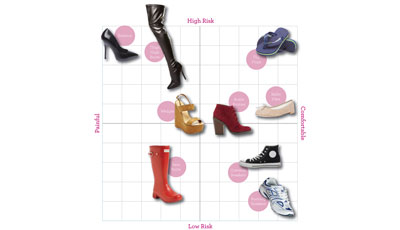By Rebecca Adams & Ellie Krupnick, Huffington Post
Graph showing which is the worst to wear. Photo from Huffington Post
We all know the pain of high heels after a long day or the soreness of walking several miles in flats. But what are our shoes actually doing to our feet — and which shoes are the ones we really should be wearing? We talked to Dr. Jacqueline Sutera, a doctor of podiatric medicine and surgery in New York City, and Dr. Neal Blitz, Chief of Foot Surgery/Associate Chairman of Orthopedics at Bronx-Lebanon Hospital and the creator of the Bunionplasty, to break down the dangers of all our favorite shoes.

STILETTOS
Wearing heels shifts your weight to the balls of your feet, which puts pressure on your foot. This also creates a balance problem: It forces your knees and hips forward, hurting your back and legs. Wearing these shoes can cause: hyperextension, ankle sprains, midfoot fractures, neuromas (benign nerve tumors), pinched nerves, bunions and hammertoes.
PLATFORM WEDGES
Wedges also have heels, which puts pressure on your foot and juts your body forward. But the heels tend to have more cushion, plus they often have platforms which protect the ball of your foot and reduce the incline. This helps with balancing. Wearing these shoes can cause: Hyperextension, ankle sprains, midfoot fractures, neuromas (benign nerve tumors), pinched nerves, bunions and hammertoes.
HIGH-HEEL BOOTIES
Depending on the heel height, these can cause similar issues to stilettos. Keeping heels to two inches or below is best — as Dr. Blitz explains, “There’s a rule of thumb: 25% of your body weight gets increased for every inch that you go, in terms of your body weight on the front of the foot.” But in booties, the material around the ankle helps hold the foot steady, putting you at less risk for injuries. “When you incorporate the ankle into the shoe, you add stability,” Dr. Blitz says. Wearing these shoes can cause: hyperextension, bunions and hammertoes.
THIGH-HIGH BOOTS
If the heels are high, you’re going to have the same issues as with stilettos — hyperextension of the back, pressure on the balls of your feet and lack of balance. But the casing around the leg creates more awareness of the leg in general, says Dr Blitz, which can help with stability. Wearing these shoes can cause: hyperextension, midfoot fractures, neuromas (benign nerve tumors), pinched nerves, bunions and hammertoes.
BALLET FLATS
“There is such a thing as too flat,” says Dr. Sutera. Shoes that are too flat don’t provide adequate arch support, cushioning or shock absorption, which those with flat feet need. However, as Dr. Blitz notes, flats are flexible and cause the muscles to work harder, making them stronger — that’s a good thing. Another problem: There’s a higher risk of the sole being pierced by a foreign object. Wearing these shoes can cause: inflammation, tendonitis, heel pain, strains, stress fractures and external injuries (e.g. stepping on a nail).
Read the full article by Rebecca Adams & Ellie Krupnick of the Huffington Post to learn more.

